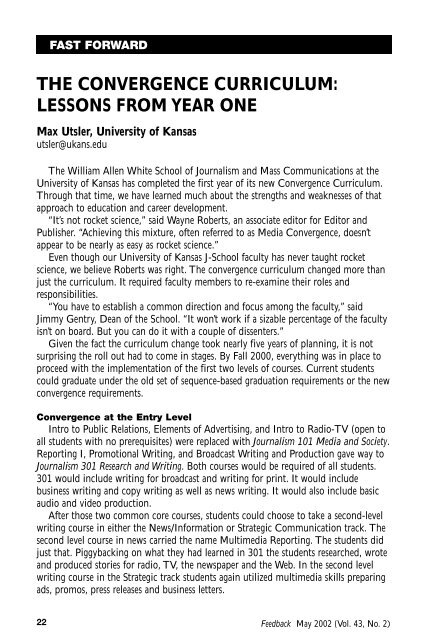Feedback May 2002 (Vol 43 No 2)
Feedback May 2002 (Vol. 43, No. 2) - Broadcast Education ...
Feedback May 2002 (Vol. 43, No. 2) - Broadcast Education ...
- No tags were found...
You also want an ePaper? Increase the reach of your titles
YUMPU automatically turns print PDFs into web optimized ePapers that Google loves.
FAST FORWARDTHE CONVERGENCE CURRICULUM:LESSONS FROM YEAR ONEMax Utsler, University of Kansasutsler@ukans.eduThe William Allen White School of Journalism and Mass Communications at theUniversity of Kansas has completed the first year of its new Convergence Curriculum.Through that time, we have learned much about the strengths and weaknesses of thatapproach to education and career development.“It’s not rocket science,” said Wayne Roberts, an associate editor for Editor andPublisher. “Achieving this mixture, often referred to as Media Convergence, doesn’tappear to be nearly as easy as rocket science.”Even though our University of Kansas J-School faculty has never taught rocketscience, we believe Roberts was right. The convergence curriculum changed more thanjust the curriculum. It required faculty members to re-examine their roles andresponsibilities.“You have to establish a common direction and focus among the faculty,” saidJimmy Gentry, Dean of the School. “It won’t work if a sizable percentage of the facultyisn’t on board. But you can do it with a couple of dissenters.”Given the fact the curriculum change took nearly five years of planning, it is notsurprising the roll out had to come in stages. By Fall 2000, everything was in place toproceed with the implementation of the first two levels of courses. Current studentscould graduate under the old set of sequence-based graduation requirements or the newconvergence requirements.Convergence at the Entry LevelIntro to Public Relations, Elements of Advertising, and Intro to Radio-TV (open toall students with no prerequisites) were replaced with Journalism 101 Media and Society.Reporting I, Promotional Writing, and Broadcast Writing and Production gave way toJournalism 301 Research and Writing. Both courses would be required of all students.301 would include writing for broadcast and writing for print. It would includebusiness writing and copy writing as well as news writing. It would also include basicaudio and video production.After those two common core courses, students could choose to take a second-levelwriting course in either the News/Information or Strategic Communication track. Thesecond level course in news carried the name Multimedia Reporting. The students didjust that. Piggybacking on what they had learned in 301 the students researched, wroteand produced stories for radio, TV, the newspaper and the Web. In the second levelwriting course in the Strategic track students again utilized multimedia skills preparingads, promos, press releases and business letters.22 <strong>Feedback</strong> <strong>May</strong> <strong>2002</strong> (<strong>Vol</strong>. <strong>43</strong>, <strong>No</strong>. 2)
















